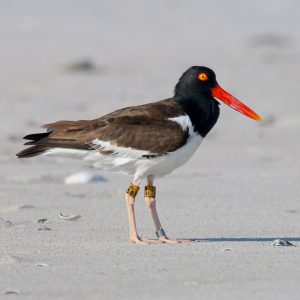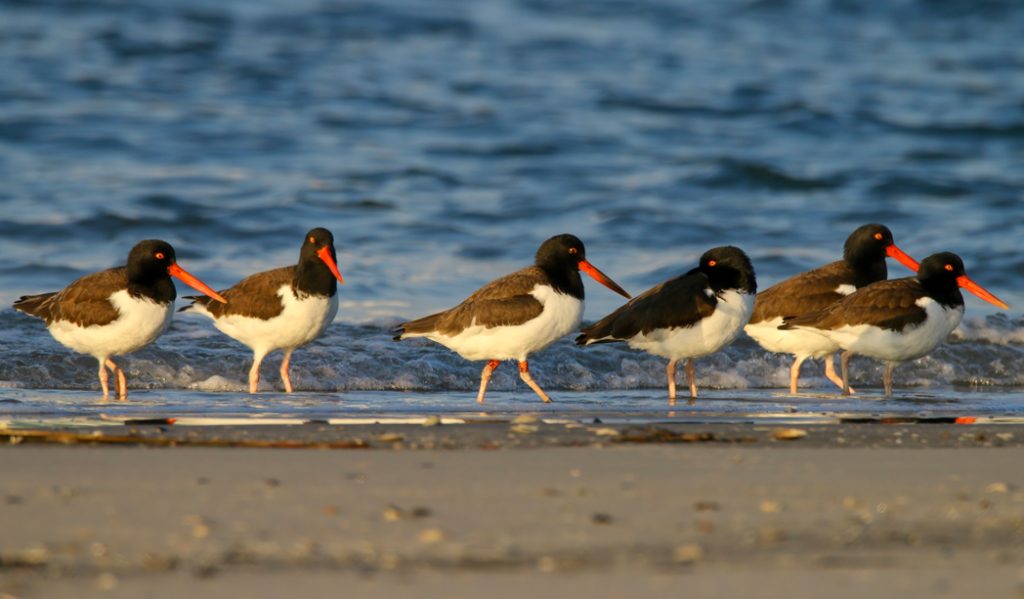by Meghan Kolk, Conservation Scientist
 If you’ve ever taken a stroll along an Atlantic Coast beach, you’ve likely encountered American Oystercatchers. These large, charismatic shorebirds draw attention with their flashy appearance, boisterous vocalizations, and entertaining behaviors. The Delaware Bay also supports a population of American Oystercatchers, but we are only just beginning to understand these birds on the bay.
If you’ve ever taken a stroll along an Atlantic Coast beach, you’ve likely encountered American Oystercatchers. These large, charismatic shorebirds draw attention with their flashy appearance, boisterous vocalizations, and entertaining behaviors. The Delaware Bay also supports a population of American Oystercatchers, but we are only just beginning to understand these birds on the bay.
As the name implies, Oystercatchers do feast on oysters, but their specialized bills can open any type of marine bivalve, including mussels and clams. Oystercatchers are restricted to coastal habitats and in New Jersey you can find them in both salt marshes and on sandy beaches.
These birds face many threats, including habitat loss from development, recreational disturbance, predation, and increased flooding from sea level rise. In addition, their breeding season coincides with peak human activity along their nesting beaches. These threats have significantly reduced the available habitat and the breeding success of these and other beach-nesting birds.
In 2000, research showed that their entire North American population (Massachusetts to Florida and across the Gulf states) consisted of only about 10,000 birds. This led to a surge in research focused on efforts to recover the population. Oystercatchers have a long lifespan but have generally low reproductive rates, making it difficult to recover quickly from a population decline. For twenty years, the population along New Jersey’s Atlantic coast has been monitored, managed, and protected, resulting in a slow but steady increase. However, little attention was paid to the birds that breed along the Delaware Bay beaches. Now, thanks to funding from the National Fish and Wildlife Foundation, a multi-partner collaboration – led by Conserve Wildlife Foundation of New Jersey and joined by the U.S. Fish and Wildlife Service and The Wetlands Institute – is giving this small population the attention it deserves.
One of our contributions to the project is to band Oystercatchers. Our trained and permitted staff safely fit adult and juvenile birds with a uniquely coded orange band on each leg, which can be read in the field with a spotting scope.
The first adult Oystercatcher was banded on Moores Beach in 2018, and until this year was the only banded Oystercatcher in the Delaware Bay region. This bird – with a band code of A76 and affectionately named “Evermoore” – has nested at this site every year since she was banded. This year we were also able to band her mate, and can now determine if this pair continues to stay together.
Something we learned from Evermoore is that when the breeding season is over she spends up to three months with a large flock of Oystercatchers at Stone Harbor Point. During the breeding season (March through July), Oystercatchers are highly territorial, and pairs defend their territories in noisy and sometimes aggressive displays. Once breeding is complete, however, they gather with other Oystercatchers in large roosting flocks throughout fall and winter. Some of the birds eventually move on from this fall “staging” area to a wintering location farther south. Others spend winters in New Jersey, and Stone Harbor Point is one of the few wintering locations in the state.
This year we have already seen other banded Oystercatchers from the Delaware Bay – including Evermoore’s offspring – spending time in the staging flock at Stone Harbor Point, demonstrating a clear connection between the habitat in the Delaware Bay region and the habitat on Seven Mile Island. Time will tell if these birds stay for the winter or migrate to a warmer climate. We hope to get reports of some of our Delaware Bay banded birds from other states over the winter so we can discover where they spend the cold months.
We are looking forward to a second season of learning more about the Delaware Bay Oystercatchers and adding more banded birds to our study. Our goal is to band at least one adult of each breeding pair, and as many chicks as possible. It will be several years before we find out where these chicks decide to settle down and whether they will stick close to their origins in the Delaware Bay or explore a different part of New Jersey – or even a different state. If you see a banded Oystercatcher and can read the code, please report it to the American Oystercatcher Working Group at amoywg.org. Reporting bands assists with the research and conservation of these beautiful birds that need our help.

